I noticed a curious occurrence taking place in the plethora of artistic developments we witnessed in Firenze. As time progressed out of the middle ages, Icons and pictures of religious figures become less concerned with portraying ethereal and almost cartoonish representations of saints. This is replaced with an attempt and often times dead-on conveyance of reality. So where robes were once in one flowing sheet on the body without an obvious curvature, they obey the laws of gravity! They have weight and the form of the figure underneath can be seen through the movement and shape of the clothing! In attempts to interpret the implications of this tendency, I am reminded of the rise of humanism and secularism in the Renaissance. No longer is the saint portrayed in a way that focuses solely on his/her heavenly role but also recognizes the importance and implications of that person's life here on earth as an end in itself. As their robes begin to fall towards the earth, so too the thoughts of their painters in a growing secularism. This is not to say though that there is a lack of appreciation for the matters both heavenly and ecclesiastical; the themes for much of the artwork under consideration were still of Biblical figures and religious devotees.
As such, the transition from an emphasis of the divine focused on in the Middle Ages towards the secularist leanings of the Renaissance can be seen in the records of halos and how they were sported by the saints. Coming into the fifteenth century, the majority of the work I have witnessed bears a more ethereal feel, harkening to Greek Orthodox iconography in a sense that doesn't concern itself with actual spacing of individuals in artistry. In the same sense of the weightlessness and spatial ignore-ance (not meant to be an insult but an observation of how they were ignored), these earlier paintings bear this likeness:
Notice the image in the middle. I apologize for the glare, but the halos are nearly as solid, if not more, than the surroundings. The halos end up conveying the same amount of weight as the bodies and heads they adorn. As our guide termed it, they're like golden dining plates behind their heads." This portrayal of halos starts transitioning in conjunction with a series of corresponding historical occurrences. Near the mid point of the 15th century, there was an ecumenical council between the Roman Catholic powers and the Eastern Orthodox figure heads. This council failed to bring much resolution. In corresponding time the Muslims were finally overtaking the capital of the Eastern Orthodox world, Constantinople. The result shows a back-tracking in the christian West from the traditional conveyance of halos as bearing similarities to those in the Eastern Orthodox church. In conjunction with the somewhat sour council and the invasion of the Turks, the portrayal of saints in Italy visibly began to change. As their clothes began showing a dependance on gravity, as spatial placement and proportions were once more restored in importance for the artists of the Italian Renaissance, so too the halos began to lose their golden solidity. Witness, for instance, the comparison between the prior halos as thick gold dinner plates and the following halo of the upside-down crucified Peter:
It is logically fallacious to draw necessary lines of causality in this relationship, but the correspondence of the rise of humanism and the departure and diminishment of halo-employment is yet worthy of note. Perhaps we see a shift in the artistic understanding of the roles of these biblical figures? Perhaps the thin rim barely perceivable upon the dome of (it's still hard to call him this after my Baptist upbringing: saint) Peter, according to my interpretation, conveys a better understanding of the earthly, secular role of Peter. The other components of this amazing, fire-resistant fresco show the earthbound figure of Peter in many of the acts of Miracles that took place throughout his life after the ascension of heaven. This Saint Peter is seen as a much heavier, earthly, secular-ly figure. The robes draped over his body evince a character fully secular and a part of the earth, leading a life of virtue and purity supreme enough to raise the dead and give the lame the gift of mobility once more through the simple passage of his shadow! It seems then that the rise of emphasis of secularism (i.e. virtue for the sake of virtuous living on this earth as opposed to living for access to heaven) and the capabilities for humanity to and be good here on this earth, i.e. humanism, are expressed in the translation of dinner-plate halos to the thin barely-seen halos present in these frescos and many others like it of the later of the fifteenth and early sixteenth century.
It is significant to recognize that this transition was not instantaneous but a gradual shift, a slow shift from plate halos to thin rims on the head. Perhaps the ultimate portrayal of this can be seen in Leonardo Da Vinci's works, of which very few if not one sole portrayal bears a halo on any saintly figure. Sadly the majority of the locales in Firenze barred us from photography but the picture is so clear in my mind, it's unshakeable. A very European Mary reads a book in a garden as the arch angel Michael pays her a visit (perhaps correlating to an annunciation?). The truly interesting peace is that this bears one of the few halos Leonardo ever crafted. Even in this light, the thin golden bar girding their domes are nothing like their plate-y, physical predecessors. Moreover, this halo was the product of a very young and forced Leonardo, but it was not long after that he held true to his own artistic and theological cogitations. This is perhaps the first and last painting he crafted with any halo involved. A noteworthy bit indeed in a Renaissance world of rising secularism and humanism.


No comments:
Post a Comment